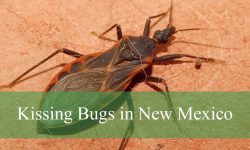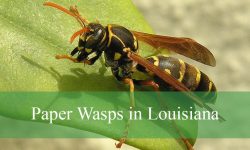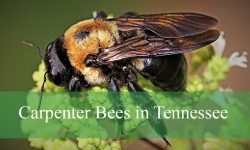North Carolina offers a wide variety of bird species, and among the most eye-catching are the red birds that bring vivid color to forests, fields, and neighborhoods. These birds range from bright and bold year-round residents to rare visitors that occasionally pass through the state during migration. Their presence adds excitement and beauty to birdwatching across all seasons.
Each red bird has its own unique features—some are entirely red, while others display just a touch of crimson on the head, chest, or belly. From the iconic northern cardinal to the secretive painted bunting, these species vary in behavior, habitat, and visibility. Some prefer the forest canopy, while others frequent feeders in suburban yards.
This guide introduces 10 red birds that can be found in North Carolina, with clear identification tips and interesting facts. Their stunning colors, combined with their songs and habits, make them some of the most memorable birds to observe in the state.
Common Red Birds in North Carolina
Summer Tanager (Piranga rubra)
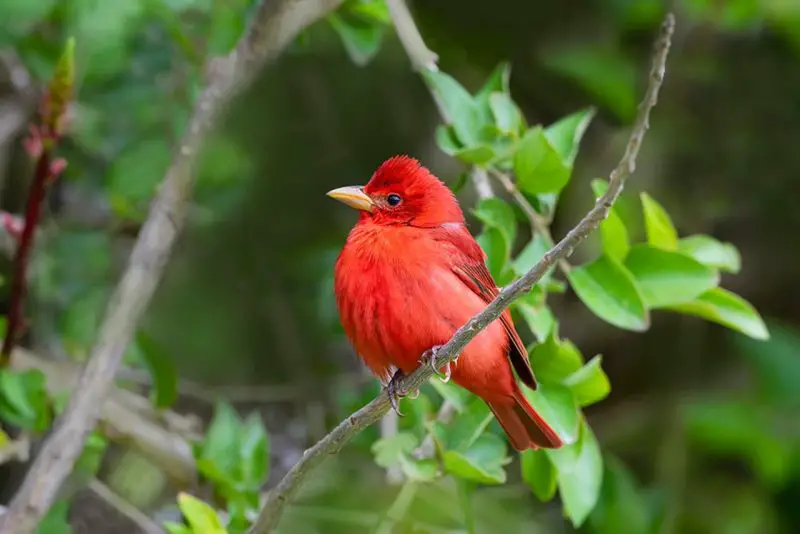
The Summer Tanager is the only entirely red songbird in North America, and its presence in North Carolina is limited to the warmer months. Adult males are a brilliant rosy-red all over, while females display golden-yellow plumage with occasional olive tones. This sexual dimorphism makes them relatively easy to identify if seen clearly.
These tanagers are medium-sized songbirds, measuring about 6.7 inches long with a wingspan of 11 to 11.8 inches. Their slightly thickened, pale bills are well-suited for catching insects. Summer Tanagers have a fondness for bees and wasps, often catching them mid-air. They are known to remove the stingers before consuming these insects. Aside from insects, they will also eat berries and small fruits.
Summer Tanagers are relatively shy and elusive, usually staying high in the canopy of deciduous and mixed forests. Their call is a distinctive, slurred “pi-ti-tuck” and their song is similar to that of an American Robin but more melodious and slower. During breeding season, males sing frequently to claim and defend their territory, while females build nests on horizontal tree branches.
In North Carolina, Summer Tanagers are typically seen from late April through early September, primarily in the Piedmont and Coastal Plain regions. They prefer large tracts of mature forest and are not commonly found in urban areas. Observers hoping to spot this species should search the upper canopy layers of oak or pine woodlands, especially near clearings or forest edges.
Northern Cardinal (Cardinalis cardinalis)
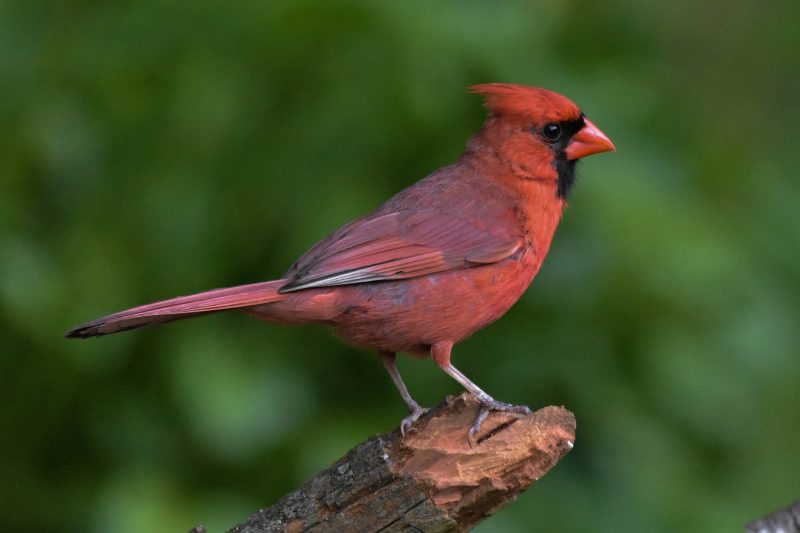
The Northern Cardinal is arguably the most recognized and beloved red bird in North Carolina. As the official state bird, it holds a special place in the hearts of locals. Males are unmistakably bright red with a contrasting black mask that surrounds the beak and eyes, creating a striking appearance. Females, though less vibrant, are still beautiful with their warm brown tones, reddish highlights on the wings and tail, and a soft crest on the head.
Northern Cardinals typically measure around 8.3 to 9.1 inches in length with a wingspan of 9.8 to 12.2 inches. They have thick, orange-red beaks that are adapted for cracking seeds, which is a major part of their diet. In addition to seeds, they also feed on fruits and insects, especially during the breeding season when protein is essential for young birds. Their clear, whistled songs and loud “chip” calls make them easy to locate, especially in the early morning.
Behaviorally, cardinals are non-migratory and maintain territories year-round. They are known for being monogamous and often mate for life. Males are particularly territorial and will aggressively defend their space, sometimes even attacking their own reflections. Nesting typically occurs in dense shrubs or small trees, where females build cup-shaped nests and lay three to four eggs per brood.
In North Carolina, Northern Cardinals are found statewide throughout all seasons. They are extremely common in suburban yards, city parks, forest edges, and thickets. Because they readily come to bird feeders—especially those offering sunflower seeds—they are frequent visitors to backyard feeding stations, making them one of the easiest red birds to observe.
Scarlet Tanager (Piranga olivacea)
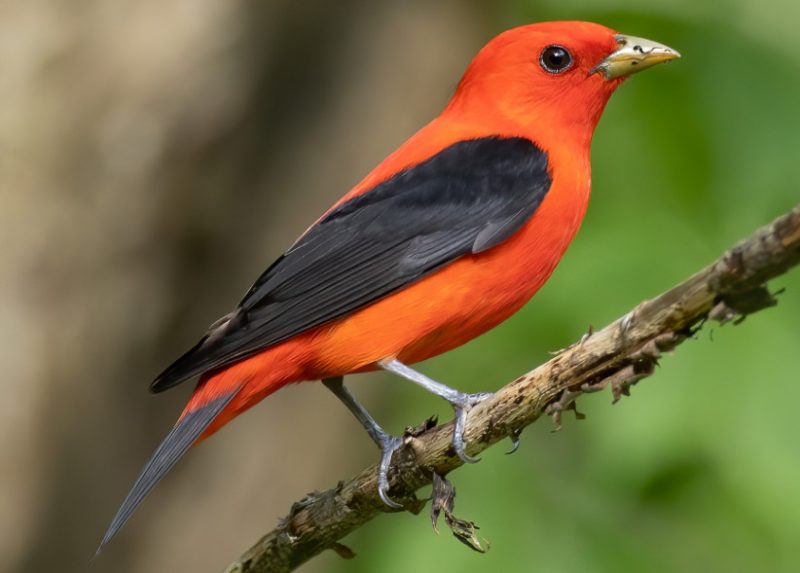
The Scarlet Tanager is one of the most visually striking birds found in North Carolina during spring and summer. Males have vibrant scarlet-red bodies contrasted with jet-black wings and tails, a color combination that stands out in the green forest. Females, on the other hand, are much more subdued in appearance, with olive-yellow bodies and darker wings.
These birds measure about 6.3 to 7.5 inches in length and have a wingspan ranging from 9.8 to 11.4 inches. Their stout, pale beaks are perfectly adapted for their omnivorous diet. Scarlet Tanagers primarily feed on insects during the breeding season, including beetles, ants, and caterpillars. In fall migration, they switch to a fruit-heavy diet, feeding on berries and other soft fruits.
Despite their bright coloration, Scarlet Tanagers are often difficult to spot because they prefer to forage and nest high in the canopy of mature deciduous forests. They are more often heard than seen, with a song that resembles a burry version of the American Robin’s and a sharp “chip-burr” call note that they give frequently. Their secretive behavior makes them a rewarding find for dedicated birders.
In North Carolina, Scarlet Tanagers are most commonly found in the mountains and foothills during their breeding season, from late April through early October. They prefer large, undisturbed hardwood forests with tall trees, such as oak, beech, and hickory. They rarely visit feeders, so forest hikes during late spring or early summer are the best times to observe them.
House Finch (Haemorhous mexicanus)
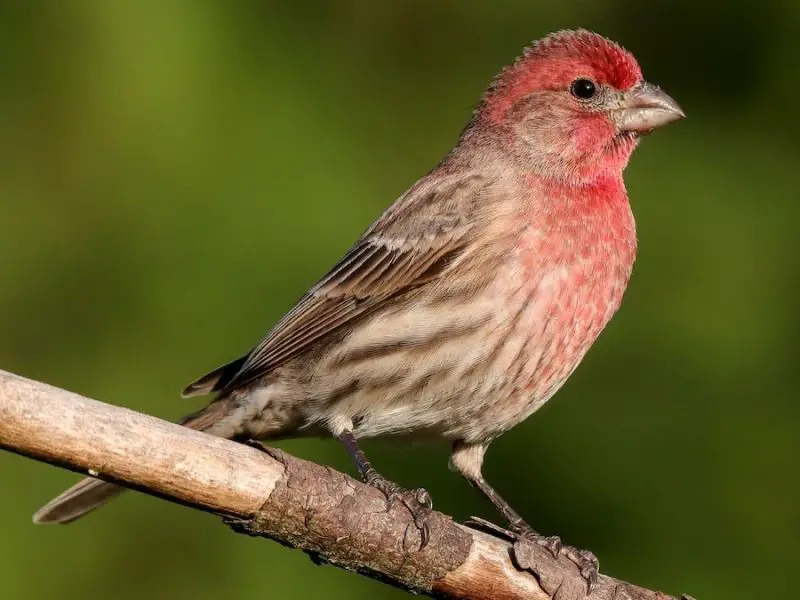
The House Finch is a small, social songbird that is widespread across North Carolina and often mistaken for more vibrantly colored species. Male House Finches have a rosy-red hue on their forehead, throat, and upper chest, which contrasts with their brown-streaked back and flanks. Females lack the red entirely and are plain brown with heavy streaking.
These birds measure about 5.1 to 5.5 inches in length with a wingspan of 7.9 to 9.8 inches. Their conical beaks are adapted for seed-crushing, and they are primarily granivorous. House Finches readily eat seeds from feeders, especially black oil sunflower seeds, millet, and thistle. In the wild, they also consume a variety of weed seeds, buds, and fruits.
House Finches are highly adaptable and thrive in human-modified environments. They are often seen perched on utility lines, hopping around feeders, or nesting on porch ledges and building crevices. These birds are monogamous and may raise several broods per year. Their cheerful, warbling song can be heard throughout the day and is often one of the first bird songs heard in the morning.
In North Carolina, House Finches are year-round residents found throughout the state, especially in suburban neighborhoods, towns, and cities. They are very comfortable around humans and often nest close to buildings or in hanging planters. Their tolerance of urban life and willingness to visit feeders make them one of the most observed red-tinged birds in the region.
Purple Finch (Haemorhous purpureus)
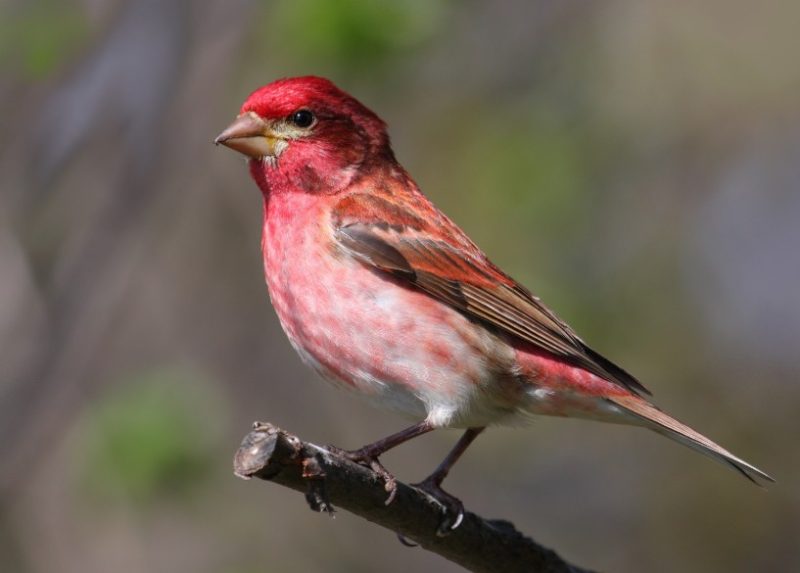
The Purple Finch is a winter visitor in North Carolina and can be easily confused with the House Finch, though the coloration is more intense. Males are covered in a rich, raspberry-red wash that spreads across the head, chest, and back, blending into streaky brown on the wings and belly. Females are distinctly streaked brown and white with a bold facial pattern.
Slightly larger than House Finches, Purple Finches measure about 6 inches in length and have a wingspan of 9 to 10.2 inches. They also have a robust, conical beak for cracking seeds. Their winter diet includes sunflower seeds, thistle, and various tree buds and fruits. At feeders, they may appear in small flocks and often mix with other finches or sparrows.
Though they can be vocal, Purple Finches are less conspicuous than their cousins and may feed quietly among foliage or near feeders. Their song is a rich, warbling series of notes, more complex than that of the House Finch. They are also known for their undulating flight and calm demeanor when feeding in groups.
In North Carolina, Purple Finches are most likely to appear from November through early March. They are more commonly seen in the Piedmont and mountain regions, particularly in wooded backyards and forest edges. Unlike House Finches, they do not breed in the state, so winter is the only chance for birders to enjoy their raspberry-red coloration.
Red Crossbill (Loxia curvirostra)
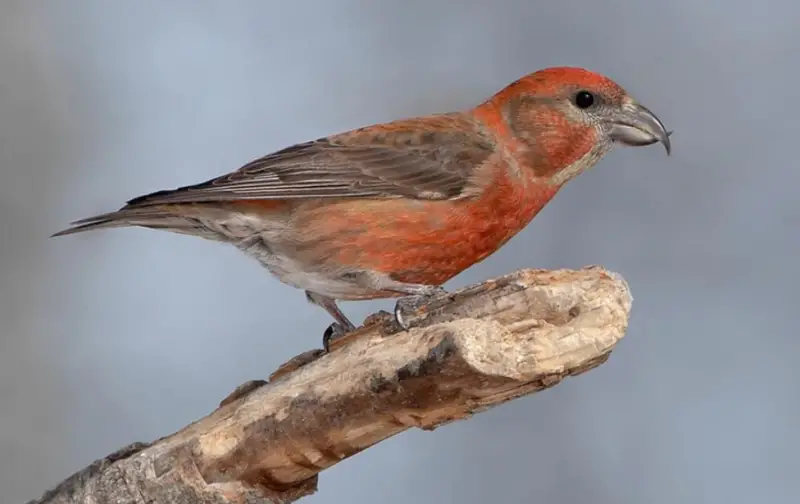
The Red Crossbill is a unique finch known for its specialized, crisscrossed bill that is perfectly adapted for extracting seeds from conifer cones. Males typically have brick-red to orangish-red plumage with dusky brown wings and tail, while females are more olive-yellow or greenish overall. Their stocky build, notched tail, and heavy bill make them easy to distinguish from other finches when seen up close.
These birds measure around 5.5 to 6.5 inches in length with a wingspan of 10 to 11 inches. Their most striking feature—the crossed mandibles—is used like a scissor to pry open tightly closed pine, spruce, or hemlock cones. Their diet is almost exclusively made up of conifer seeds, though they may also eat buds, insects, and grit to aid digestion. Their call is a sharp, metallic “jip-jip,” and their vocalizations vary across different populations or “types,” some of which are genetically distinct.
Red Crossbills are nomadic and irruptive, meaning their presence in an area can vary greatly from year to year depending on cone availability. They tend to forage in flocks high in coniferous trees, often hanging upside down or moving acrobatically through branches. During breeding, which may occur any time of year, they build cup-shaped nests in the fork of evergreen trees and raise young when food is abundant.
In North Carolina, Red Crossbills are primarily observed in the higher elevations of the western mountains, such as the Blue Ridge and Great Smoky Mountains. They are found in mature conifer forests, especially where red spruce, eastern hemlock, or white pine are common. Sightings in the state are occasional and often tied to cone crop cycles, making them an exciting species for birders visiting the region during fall or winter.
Vermilion Flycatcher (Pyrocephalus obscurus)
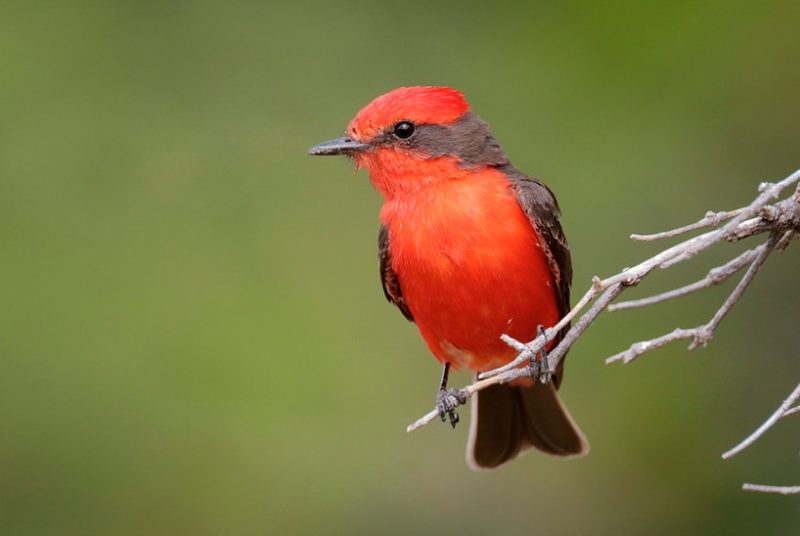
The Vermilion Flycatcher is one of the most visually stunning red birds in North America, though it is only rarely seen in North Carolina. Adult males are brilliant crimson-red on the underparts, face, and crown, with contrasting dark brown to blackish wings, back, and tail. Females and immatures are much duller, with a pale belly, grayish back, and a salmon or pinkish wash on the lower underparts.
This small flycatcher measures about 5.1 to 5.5 inches long with a wingspan of 9 to 9.5 inches. It has a thin, straight bill adapted for catching flying insects. Vermilion Flycatchers are aerial insectivores, often seen perching conspicuously on low branches or fences before darting out to snatch insects in mid-air. Their flight is quick and fluttery, and they frequently return to the same perch after each foraging attempt.
Though their behavior is typical of most flycatchers, the male’s vibrant color sets them apart in the field. They sing a series of high-pitched, buzzy notes and perform fluttering display flights during the breeding season. Nesting usually occurs on horizontal branches or in shrubs, and both parents participate in raising the young. Outside of breeding, they remain relatively solitary or in pairs.
In North Carolina, the Vermilion Flycatcher is a rare vagrant, with only a few confirmed records, mostly along the coast or in open areas near salt marshes and agricultural fields. These birds typically occur during fall or winter and may stay for a few days to weeks before moving on. Birders hoping to spot one should keep an eye on rare bird alerts or visit known sighting locations near the Outer Banks or southeastern counties.
Painted Bunting (Passerina ciris)
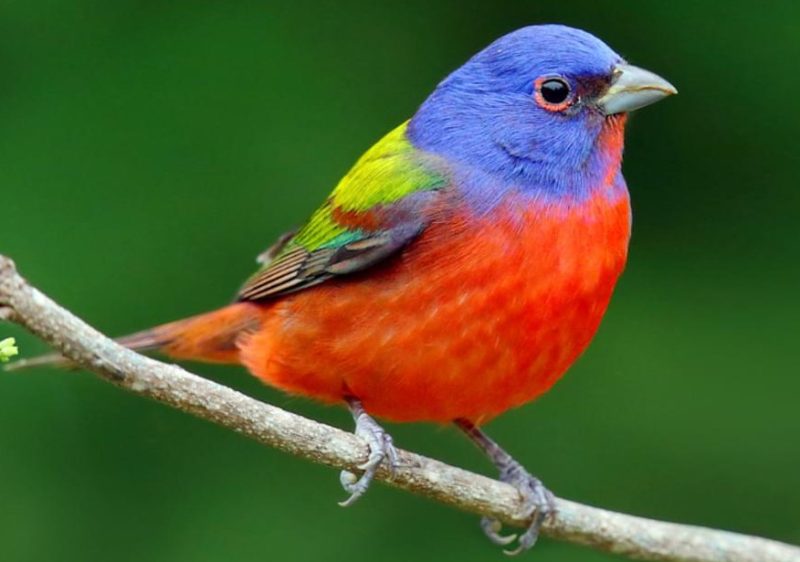
The Painted Bunting is one of the most visually striking birds in North America, and during the breeding season, adult males display a dazzling mix of colors. Their bellies and underparts are vivid red, contrasting with a bright blue head, green back, and yellow-green shoulders. Females and juveniles, in contrast, are a uniform greenish-yellow, providing excellent camouflage in dense foliage. While not entirely red, the male’s red belly makes this bird a distinctive addition to any red bird list.
This small songbird measures around 4.7 to 5.5 inches in length with a wingspan of 8.3 to 9.1 inches. Painted Buntings have short, thick bills adapted for seed-eating, though they also consume insects, especially during breeding season. Their song is a sweet, warbling series of notes often heard from hidden perches deep in shrubs or low trees.
Painted Buntings can be surprisingly secretive despite their bright colors. Males often sing from concealed spots and are most active at dawn and dusk. They build their nests low in dense vegetation, where the female incubates the eggs. During the breeding season, they can be territorial and may chase off intruders with fluttering displays and vocalizations.
In North Carolina, Painted Buntings are found primarily along the southeastern coast from May through August. They favor shrubby habitats near maritime forests, thickets, brushy fields, and coastal scrub. Places like the Wilmington area and nearby barrier islands are the best locations to spot them. After the breeding season, they migrate south to Florida, the Caribbean, and Central America.
Red-headed Woodpecker (Melanerpes erythrocephalus)
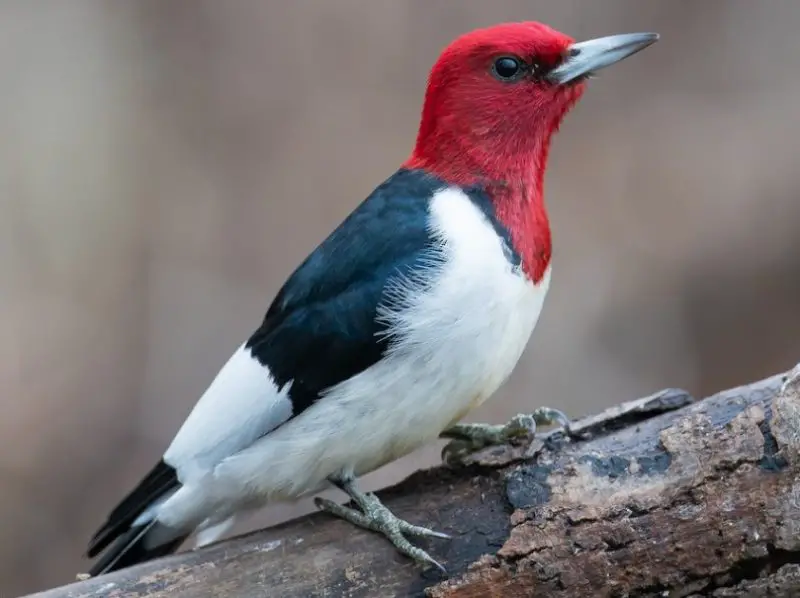
The Red-headed Woodpecker is a striking and unmistakable bird due to its brilliant crimson-red head, neck, and throat. The rest of its body features bold black and white contrasts—black upperparts and tail, a bright white belly, and large white wing patches visible in flight. Both sexes look alike, and the clean, glossy colors make this species stand out among North Carolina’s woodpeckers.
This medium-sized woodpecker measures about 7.5 to 9.1 inches long with a wingspan of 16 to 17 inches. It has a straight, chisel-like bill used for pecking and drilling. Unlike some woodpeckers that forage only on trees, the Red-headed Woodpecker often catches insects mid-air, gleans them from tree bark, or even stores food like acorns and nuts in tree crevices for later consumption. It also eats fruits, seeds, and occasionally small vertebrates.
These woodpeckers are known for their bold behavior and loud vocalizations, which include sharp “queer” or “churr” calls. They nest in tree cavities, often in standing dead trees or snags, and may reuse the same site over multiple years. They are one of the few woodpeckers that will aggressively defend their territory and food caches from other birds.
In North Carolina, Red-headed Woodpeckers are locally common in open woodlands, especially those with large dead trees, such as oak savannas, pine groves, and old orchards. They are more frequently found in the Piedmont and parts of the Coastal Plain than in heavily forested mountain regions. Habitat loss has reduced their numbers in some areas, but they remain a memorable sight where they still occur.
Red-bellied Woodpecker (Melanerpes carolinus)
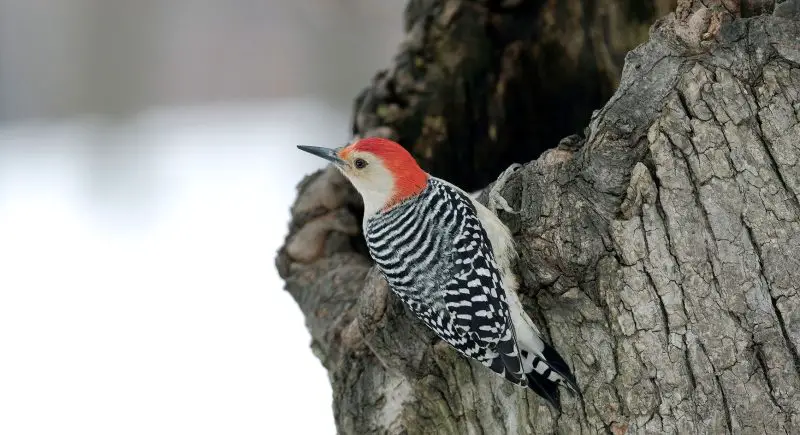
Despite its name, the Red-bellied Woodpecker’s red belly is often hard to see. The most visible red is on the top of the head and nape—males have red from the bill to the nape, while females have red only on the back of the head. The rest of the body is covered in black and white barring across the back and wings, with a pale, slightly reddish-tinted belly.
These woodpeckers are medium-sized, measuring about 9.4 inches long with a wingspan of 13 to 16.5 inches. They have long tongues and sturdy, pointed bills that allow them to probe bark for insects and larvae. Red-bellied Woodpeckers have a varied diet including beetles, ants, spiders, seeds, berries, and even tree sap. They frequently visit backyard feeders for suet, peanuts, and sunflower seeds.
Known for their rolling “churr-churr” calls and drumming, these birds are often heard before they’re seen. They cling vertically to tree trunks and branches and are agile as they move along the bark in search of food. During nesting season, they excavate cavities in dead or decaying trees, where they lay a clutch of four to six eggs.
In North Carolina, Red-bellied Woodpeckers are abundant year-round and widespread throughout all regions of the state. They are commonly seen in woodlands, urban parks, backyards, and forest edges—essentially anywhere with mature trees. Their adaptability to both natural and suburban environments makes them one of the most familiar and frequently observed woodpeckers in the region.
FAQ about Red Birds in North Carolina
What are the most common red birds in North Carolina?
The most common red birds in North Carolina include the northern cardinal, house finch, and red-bellied woodpecker. These species are found year-round in a variety of habitats, including backyards, parks, and woodlands. The northern cardinal is especially abundant and is also the official state bird.
Are there any fully red birds in North Carolina?
Yes, species like the summer tanager and vermilion flycatcher (rare) are completely red in adult males. The summer tanager is regularly seen during the breeding season, particularly in the Piedmont and Coastal Plain. The vermilion flycatcher is a rare vagrant and only occasionally recorded along the North Carolina coast.
What red birds can be seen in North Carolina during winter?
In winter, you may spot house finches, northern cardinals, red-bellied woodpeckers, and occasionally purple finches and red crossbills. While most red-colored birds are permanent residents, some like the purple finch and red crossbill are migratory or irruptive and appear mainly during the colder months.
Which red birds have unique coloration or patterns?
The scarlet tanager is notable for its scarlet body and black wings, while the painted bunting male displays a red belly with a blue head and green back. The red-headed woodpecker has a crimson head and stark black-and-white wings, and the red-bellied woodpecker shows red on the crown and nape, despite its misleading name.
Where is the best place to see red birds in North Carolina?
Red birds can be seen throughout the state, but the Coastal Plain and Piedmont regions are particularly good during spring and summer for species like the painted bunting and summer tanager. Mountain regions are better for spotting birds like the scarlet tanager and red crossbill. Urban areas and feeders attract common species such as house finches and cardinals.
Do red birds in North Carolina visit bird feeders?
Yes, many red birds like the northern cardinal, house finch, purple finch, and red-bellied woodpecker frequently visit backyard feeders. They are especially attracted to black oil sunflower seeds, suet, peanuts, and fruit. Providing a variety of food and fresh water will increase your chances of attracting these colorful birds.
Are all red birds in North Carolina actually red?
Not all red birds are fully red. For example, the red-bellied woodpecker has only a small reddish wash on the belly, and the painted bunting has a red belly but a multicolored body. Female counterparts of many red bird species tend to be less vibrant, with more subdued colors like olive, brown, or yellowish tones.
Are there any conservation concerns for red birds in North Carolina?
Some red birds like the red-headed woodpecker are experiencing population declines due to habitat loss and fragmentation. Maintaining open woodlands, preserving dead trees for nesting, and creating bird-friendly environments can help support their populations. Most other red birds, such as cardinals and finches, are currently stable or increasing.


